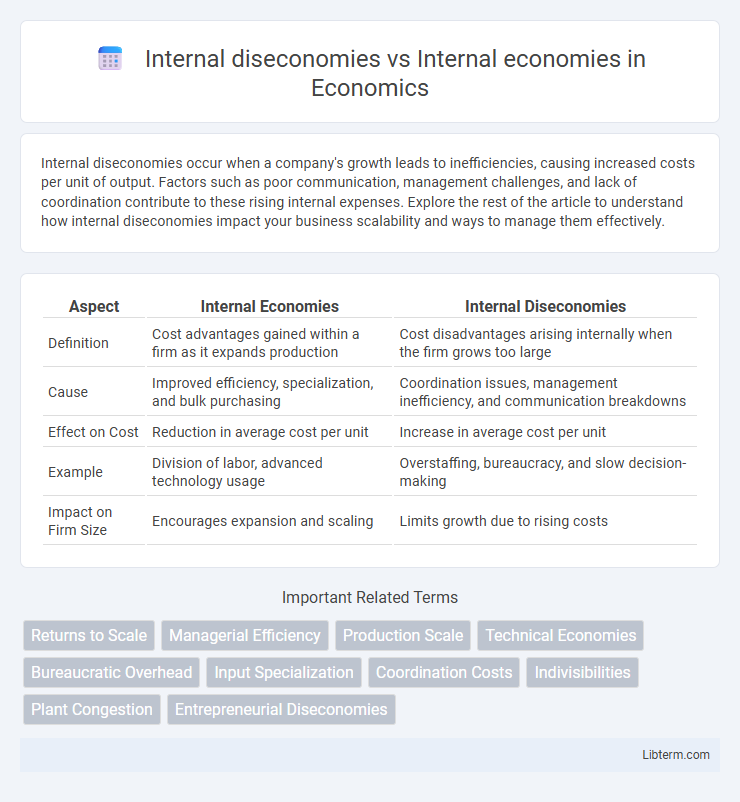Internal diseconomies occur when a company's growth leads to inefficiencies, causing increased costs per unit of output. Factors such as poor communication, management challenges, and lack of coordination contribute to these rising internal expenses. Explore the rest of the article to understand how internal diseconomies impact your business scalability and ways to manage them effectively.
Table of Comparison
| Aspect | Internal Economies | Internal Diseconomies |
|---|---|---|
| Definition | Cost advantages gained within a firm as it expands production | Cost disadvantages arising internally when the firm grows too large |
| Cause | Improved efficiency, specialization, and bulk purchasing | Coordination issues, management inefficiency, and communication breakdowns |
| Effect on Cost | Reduction in average cost per unit | Increase in average cost per unit |
| Example | Division of labor, advanced technology usage | Overstaffing, bureaucracy, and slow decision-making |
| Impact on Firm Size | Encourages expansion and scaling | Limits growth due to rising costs |
Introduction to Internal Economies and Diseconomies
Internal economies refer to cost advantages that a firm experiences as it increases production, benefiting from factors such as improved specialization, better technology, and bulk purchasing. In contrast, internal diseconomies occur when a firm grows beyond an optimal size, leading to inefficiencies like increased coordination costs, communication breakdowns, and managerial difficulties. Understanding the balance between internal economies and diseconomies is crucial for firms aiming to optimize their scale of operations and maintain competitive cost structures.
Definition of Internal Economies
Internal economies refer to cost advantages that a firm gains as it increases its scale of production, leading to lower per-unit costs due to factors like improved labor specialization, better managerial efficiency, and bulk purchasing of raw materials. These economies can manifest in various forms such as technical, managerial, financial, marketing, and purchasing economies, all contributing to enhanced productivity within the firm. In contrast, internal diseconomies arise when a firm grows too large, causing inefficiencies like communication breakdowns, coordination problems, and increased bureaucracy that increase per-unit costs.
Types of Internal Economies
Internal economies of scale include technical economies, where improved machinery and technology enhance production efficiency; managerial economies, achieved through specialized management and division of labor; and financial economies, gained via better credit terms and lower interest rates. Marketing economies arise from bulk purchasing and advertising cost reductions, while risk-bearing economies stem from diversifying product lines to spread business risk. Conversely, internal diseconomies occur when firm growth leads to inefficiencies such as coordination problems, communication breakdowns, and bureaucratic delays, ultimately increasing average costs.
Definition of Internal Diseconomies
Internal diseconomies refer to the rising per-unit costs within a firm as it expands beyond an optimal size, causing inefficiencies and reduced productivity. This occurs due to factors such as managerial inefficiencies, communication breakdowns, and resource misallocation that hinder smooth operations. Contrastingly, internal economies involve cost advantages gained from increased scale and efficiency during expansion.
Types of Internal Diseconomies
Internal diseconomies arise when a firm's growth leads to inefficiencies, contrasting with internal economies that drive cost advantages through expansion. Types of internal diseconomies include managerial diseconomies, where increased complexity hampers coordination; technical diseconomies, resulting from overuse of equipment or labor inefficiencies; and financial diseconomies, which occur due to higher borrowing costs or misallocation of capital. Understanding these diseconomies helps businesses optimize scale without sacrificing operational efficiency.
Key Differences Between Internal Economies and Diseconomies
Internal economies of scale occur when increasing production leads to lower average costs due to efficiencies such as improved technology, bulk purchasing, and specialization of labor. In contrast, internal diseconomies arise when a firm's expansion results in higher average costs caused by factors like management inefficiencies, communication problems, and resource limitations. The key difference lies in the cost behavior: economies reduce per-unit costs as scale grows, while diseconomies increase them, impacting overall firm profitability and operational effectiveness.
Causes of Internal Economies
Internal economies arise from factors within a firm that enhance productivity and reduce average costs, such as specialization of labor, advanced technology adoption, and efficient managerial practices. Causes of internal economies include bulk purchasing of inputs which lowers material costs, improved operational efficiency through better equipment and processes, and enhanced employee skills increasing output quality and speed. These factors contribute to economies of scale by enabling firms to spread fixed costs over greater production volumes, thus achieving lower per-unit costs.
Causes of Internal Diseconomies
Internal diseconomies arise when a firm expands beyond its optimal size, causing inefficiencies that increase average costs. Key causes include managerial inefficiencies due to complex coordination, communication breakdowns, and increased bureaucracy. Other factors include labor conflicts and resource misallocation, which hinder productivity and escalate operational expenses.
Impact on Business Growth and Efficiency
Internal economies boost business growth and efficiency by reducing average costs through factors like improved specialization, technological advancements, and bulk purchasing. Internal diseconomies arise when firms grow beyond optimal size, causing inefficiencies such as management challenges, communication breakdowns, and increased operational complexity. Balancing these forces is crucial for sustaining scalable expansion and maintaining competitive advantage.
Strategies to Manage Diseconomies and Maximize Economies
Implementing advanced automation and workforce training helps manage internal diseconomies by enhancing operational efficiency and reducing costs. Streamlining organizational structure and improving communication channels prevents coordination problems and maximizes internal economies of scale. Leveraging technology integration and continuous process improvement fosters sustainable growth while minimizing inefficiencies within the firm.
Internal diseconomies Infographic

 libterm.com
libterm.com